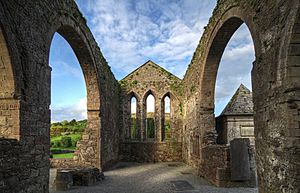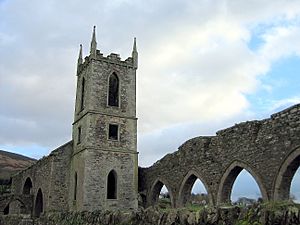Baltinglass Abbey facts for kids
| Mainistir Bhealach Conglais | |

View of Baltinglass Abbey looking across the Slaney
|
|
| Monastery information | |
|---|---|
| Other names | Vallis Salutis |
| Order | Cistercians |
| Established | 1148 |
| Disestablished | 1536 |
| Mother house | Mellifont Abbey |
| Diocese | Kildare and Leighlin |
| People | |
| Founder(s) | Diarmait Mac Murchada |
| Architecture | |
| Functional Status | In ruins |
| Heritage designation | National Monument #230 |
| Style | Romanesque |
| Site | |
| Location | Church Lane, Baltinglass, County Wicklow, Ireland |
| Coordinates | 52°56′38″N 6°42′35″W / 52.943886°N 6.709747°W |
| Public access | yes |
Baltinglass Abbey is an old Cistercian abbey in Baltinglass, Ireland. It was started in 1148. Today, it is a National Monument, meaning it is a protected historical site.
Contents
Where is Baltinglass Abbey Located?
Baltinglass Abbey sits on Church Lane in the town of Baltinglass. It is on the east side of the River Slaney.
The Story of Baltinglass Abbey

Baltinglass Abbey is in a valley near the River Slaney. This area is part of the Wicklow Mountains. It was a very important spot because it was a main path between the north and south parts of Leinster. The name Belach Conglais means "pass of Cú Glas." Cú Glas was a hero from old stories.
Archaeological finds show that Baltinglass was important even before the abbey. In 1148, Diarmait Mac Murchada, who was the King of Leinster, built the monastery here. He likely wanted to show his power in the area.
How the Abbey Was Founded
Baltinglass Abbey was a "daughter house" of Mellifont Abbey. Mellifont was another Cistercian abbey located near Drogheda. Diarmait Mac Murchada gave Baltinglass the Latin name Vallis Salūtis. This means "Valley of Salvation". He also gave the abbey eight pieces of land to help support it.
The first parts of the abbey were finished by 1170. In 1180, Baltinglass Abbey became the "mother house" for Jerpoint Abbey. By 1228, records show that 36 monks and 50 lay brothers lived at Baltinglass.
A Place of Shelter
In October 1290, the abbey became a safe place for many travelers. These people were moving through the area and needed help. The monks and lay brothers at the abbey offered them shelter and food. They stayed for six days and nights. Some people who were too sick to travel stayed at the abbey until spring. This shows how important abbeys were as places of refuge in the past.
The Abbey's Later Years
Baltinglass Abbey was active for almost 400 years. However, it was closed down in 1536. This happened during the time known as the Dissolution of the Monasteries. During this period, many monasteries in Ireland were shut down. The abbey's land was then given to Edmond Butler, 3rd/13th Baron Dunboyne.
Later, in 1815, a Church of Ireland church was built inside the abbey's ruins. But this church also closed its doors in 1883.
What You Can See Today

Tower and arcade at the abbey.
|
The main church building is still standing, and it is 56 meters long. Some parts of the cloister (a covered walkway) also remain from the 12th century. The church has a nave (the main part) with aisles on the sides. It also has a chancel and a square presbytery (the area around the altar). There are two transepts, which are parts that stick out from the main building. Small chapels come off these transepts.
A 12th-century doorway connects the south aisle of the church to the choir area. Some of the original cloister, which is south of the church, has been rebuilt. The church also has parts added in the 13th and 15th centuries. The windows on the east side and the tower were built in the 1800s.
The stone carvings at the abbey are very interesting. They show human and animal figures. The building style mixes Cistercian design with Irish Romanesque art. The decorations on the capitals (the tops of columns) are similar to those found at Jerpoint, which was a "daughter house" of Baltinglass.


